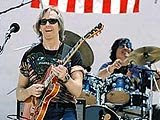My Writing Process, Part 2
Breaking the Patterns
 When it does come time to write the chords to the song, I'll try to avoid the typical 4-chord progression, where each chord lasts for the same length of time. One way is to simply vary the amount of measures each chord lasts. Or, you can go back and forth between two chords; then when you introduce additional chords, they have drama.
When it does come time to write the chords to the song, I'll try to avoid the typical 4-chord progression, where each chord lasts for the same length of time. One way is to simply vary the amount of measures each chord lasts. Or, you can go back and forth between two chords; then when you introduce additional chords, they have drama. Another "trick" I use is to change the chords at unexpected times. For instance, if your verse was based on two chords, it might go like this:
Chord 1 | Chord 1 | Chord 2 | Chord 2 | repeat
But what if you change in different spots? Like this:
Chord 1 | Chord 2 | Chord 2 | Chord 1 | repeat
It seems like a simple modification, but what it does is to put the changes where you don't expect, and keep the chord the same where you might expect a change. It's all about breaking the pattern.
Getting Feedback, and Listening
One of the big advantages of having a working band like Savor, is that when playing as a Santana Tribute Band, we can throw in our own songs, too. As long as the songs fit the style (Latin Rock), many people don't know they're original. After all, beyond the classic hits: Oye Como Va, Black Magic Woman, Evil Ways, Smooth, Europa, and a few others, most people are not familiar with Santana's catalog.
 When you play an original song like that for people who have never heard it, the reaction is honest, and, often, brutal. My rule of thumb was: play the song for a few different audiences. If they didn't react (dancing, nodding their heads, clapping enthusiastically afterwards), I knew I hadn't done my job as a writer. I would make changes, reintroduce it to audiences, and keep doing that until I did get a positive reaction.
When you play an original song like that for people who have never heard it, the reaction is honest, and, often, brutal. My rule of thumb was: play the song for a few different audiences. If they didn't react (dancing, nodding their heads, clapping enthusiastically afterwards), I knew I hadn't done my job as a writer. I would make changes, reintroduce it to audiences, and keep doing that until I did get a positive reaction.Frustrating? Yes. Sometimes I think the players in the band consider me a bit loony -- especially after I had re-written one of the songs three times during the course of a couple of years! But in the end, I really believe that we wound up with a stronger, more effective song. After all, the purpose of songwriting is to reach people, right?
Writing vs. Arranging
This is sometimes difficult to explain to non-musicians, and in fact the lines blur. The way I think of it is, the basic, stripped-down lyrics (if it's a vocal song), melody and chord progression together make up the song writing.
What the bass player does, how the drums interact with the percussion, the guitar riffs that go under and in between everything else -- that's the arrangement.



